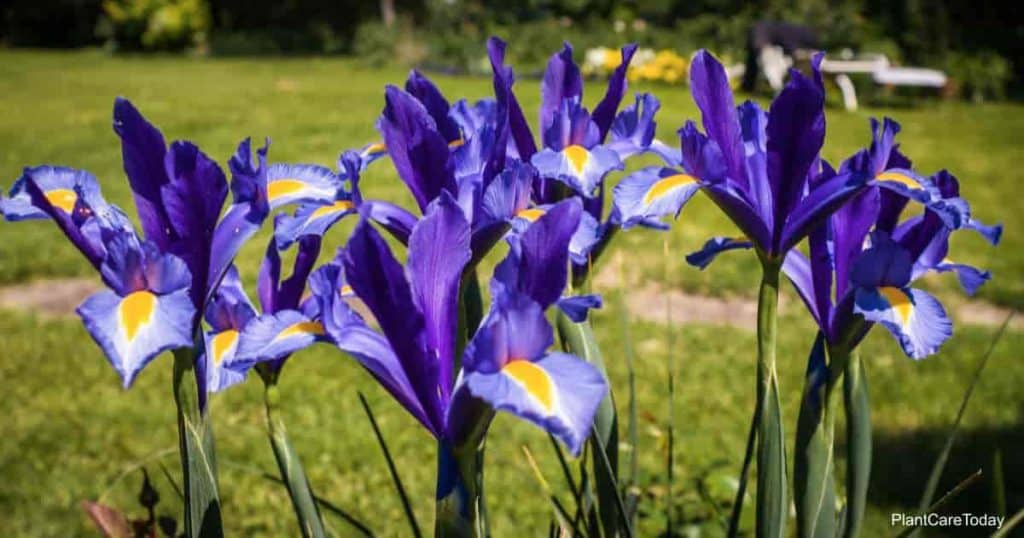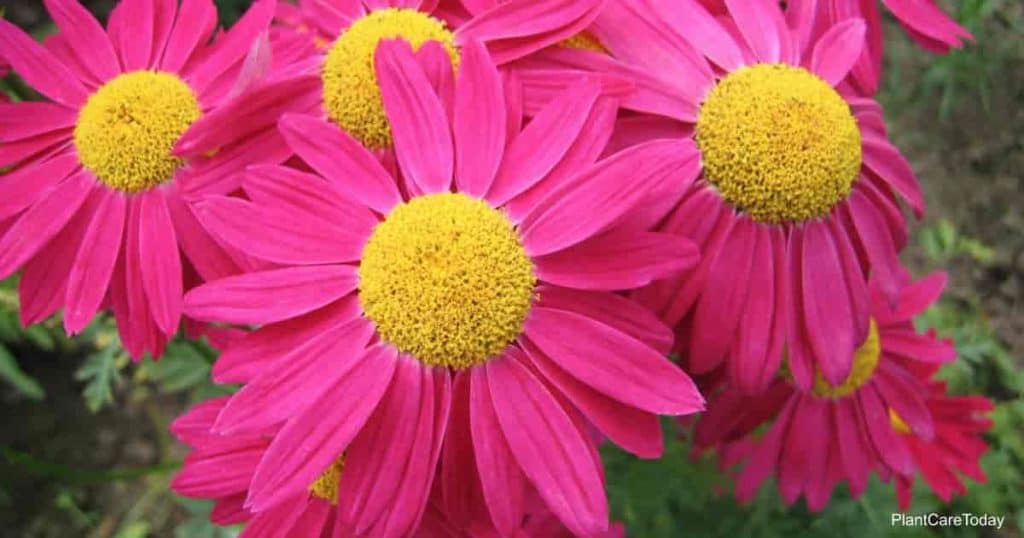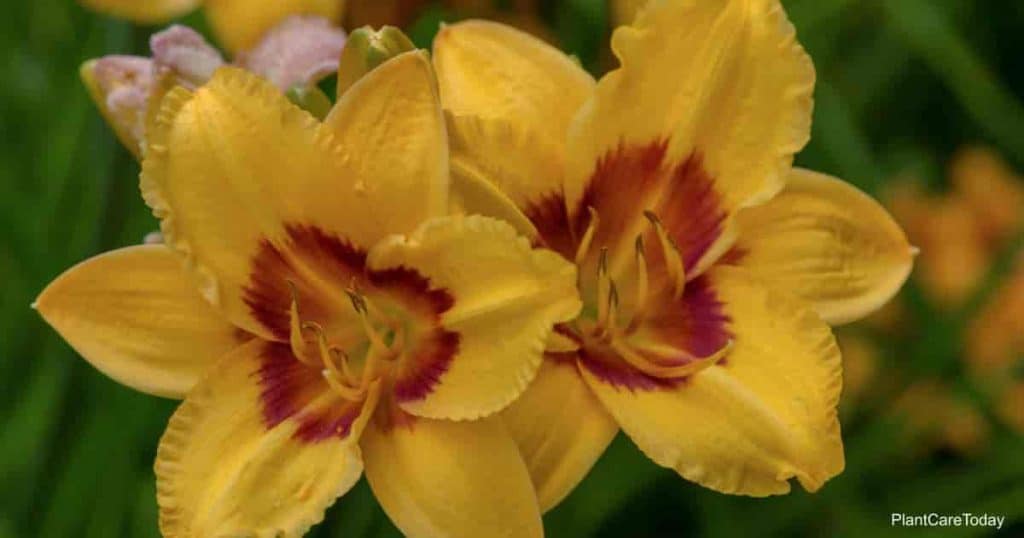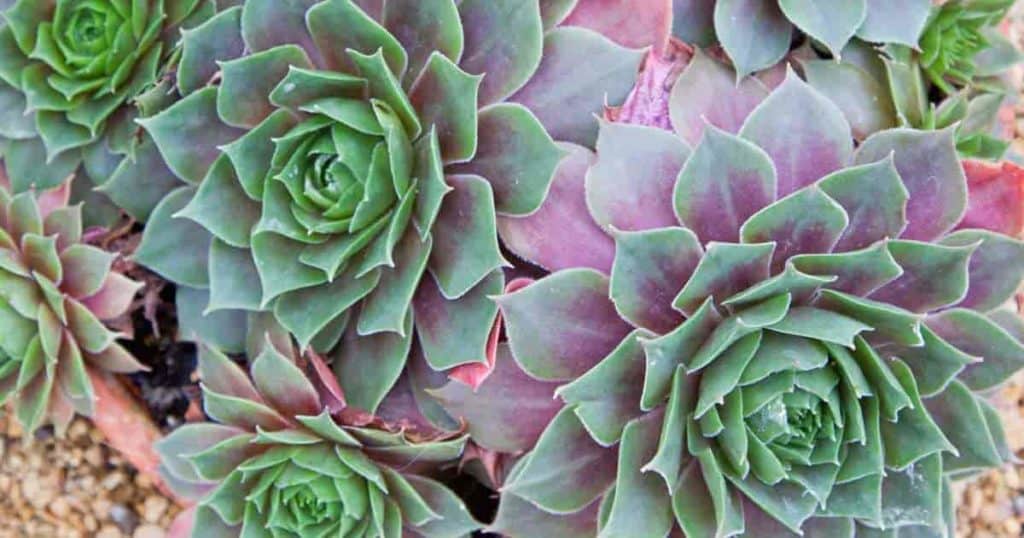Dividing and transplanting is a shock to any plant. It loosens its root attachment to the soil which stops its normal growing functions until the plant becomes established again.
Learn more in our article 10 Ways to Minimize Plant Transplant Shock

To reduce the after-effects of root damage, the work can be done when the plant is dormant, and growth is greatly slowed down or in a state of rest.
The general rule is to divide spring and early summer-flowering plants in August and September and to divide late summer- and fall-flowering plants in early spring.
Any plant on the borderline of hardiness is best divided in the spring.
No matter when this work is done, to assure success, the hole for the plant must be deep enough and wide enough so that roots can be spread out naturally.
Any broken or bruised roots should be removed.
The plant is held in position in the hole, and soil is poured around the roots and firmed thoroughly so that the roots are in close contact with the soil to enable the plant to repair the root damage quickly.

Usually, one watering is all that is required for a dormant plant.
Over-watering may cause waterlogged soil with subsequent rotting of the roots before they function normally again.
Exceptions from the general rule include iris and painted daisies (pyrethrums) which may be divided and reset after blooming.
Oriental poppies that go dormant early should be moved before they start new leaf growth in late summer.
Hemerocallis and Hen-and-Chickens are so congenial that one can reset them at almost any time.
Dividing Iris Plants
Iris (especially the bearded iris) is one of the easiest plants to divide and transplant.

It requires dividing whenever the rhizomes (the thickened underground shoots) become so crowded that they commence growing on top of each other.
- After the plant has finished blooming, cut off the old flower stalks and shorten the leaves to a third of their length.
- Lift the clump and shake the soil from the roots.
- Cut the rhizome with a sharp knife into pieces so that each has at least one strong fan of leaves, or if preferred, two or three.

- Most experts advise covering the rhizomes with an inch of soil.
- Any that might be a bit tender would be exposed to more winter injury if the rhizomes were not covered.
- Others say that shallow planting with about half of the rhizome exposed is advisable, especially in heavy soil.
- Observe the method used by the most successful iris growers in your area.

More On Propagating Iris Plants
Transplanting Iris Cover the Rhizomes or Not?
I planted a number of choices irises one summer and, a couple of years later, asked a fine iris grower why several had not bloomed for me.
The rhizomes had been covered well, and as they were on a side bank, more soil had washed on them.

She was kind, and as she looked at the plants, she seemed to hesitate to tell me that they were covered too deep, but I could sense how she longed to scratch away some of the soil.
I reset them that summer and left the tops of the rhizomes exposed. When my iris friend came in the spring, I showed her the plants and asked her opinion.
In the most tactful way, she told me she liked to have the rhizomes covered. I could feel now how she longed to put more soil over my plants.
We can learn much by following the methods of those who understand the needs of their plants so completely.

Discard any pieces of the rhizomes that do not have strong leaf growth.
Dividing and Transplanting Painted Daisies
If an extra good color or, perhaps, a fine double form appears among seedling-painted daisies, we may want more of those particular plants.

- As soon as the painted daisies finish blooming, dig them, and pull the plants apart so that each division has a good number of fibrous roots.
- Cut off the flower stems and shorten the tops if they are inclined to fall over.
- Water well after planting and apply a mulch of rotted straw or decayed leaves. Shade for a few days.
TIP: Plants of the painted daisies (pyrethrum) may be successfully divided and reset after blooming.

Other early-blooming plants that can be divided after the flowers fade are:
- Hepaticas
- Phlox subulata
- Phlox divaricata
- Phlox pilosa
- Primula polyanthus
- The Hardy Violets

Dividing and Transplanting Oriental Poppies
We wait to move the Oriental poppy until after the foliage dies down in mid-summer.
- The fleshy roots are rather long and unwieldy. Some may be broken off when dug.
- The parts left in the ground will send up new shoots.
- Replant the divided roots, digging the hole deep enough so the crowns can be about three inches below the surface.
- Firm the soil well about the roots up to the top of the crowns.
- Water well, then fill in with dry soil. New leaves will grow in late summer without further attention.
TIP: Do not divide and reset Oriental poppies until the foliage dies down in midsummer. But get it done before leaf growth starts again in late summer.
Dividing and Resetting Daylilies Separating Clumps
If, for any reason, one wants to divide and reset hemerocallis in June, it can be done with perfect safety.

The season’s blossoms will be sacrificed, but if left in sizable clumps, the increase of plants will bloom the next season.
If the roots do not separate easily, the clumps can be soaked in water after digging to remove the soil and then can usually be pulled apart with the hands.
Or, after digging, one can push two spading forks back to back through the clump and pry them apart enough to finish with the hands for the planting-size pieces.

They can be divided into single divisions with at least one growing shoot with roots, or for quicker results (blossoms and garden use), leave three or more ramets (divisions) together.
Shorten the leaves to ten inches or less, and set them at the same depth as before. Water well and mulch to preserve moisture.
Details on Daylily Care

Hen-and-Chickens
The botanical name of the cunning little rosettes we call hen-and-chickens is Sempervivum which means “live forever.”

Planted in the partial shade among rocks (or on the rocks if there are slight depressions to hold a bit of soil), the various kinds multiply with surprising rapidity.
There are almost always offsets to give to interested garden visitors at any time during the growing season. They are especially appealing to the young gardener.
Every single rosette taken from the parent clump will form another cluster of rosettes if planted carefully. It will probably have a few roots, but if not, roots soon form in moist, well-drained soil.
Learn more about Sempervivum Care

The Improbables
NOTE: An established plant of dictamnus resents being transplanted. When grown in a sunny location and not disturbed, a plant has been known to outlive three generations.
Having witnessed my mother transplant annual double poppies successfully (a plant usually considered impossible to move) I hesitate to say that there is any plant that one could not reset.

But one must choose an opportune time and use the greatest care not to disturb the root system of those that are difficult or almost impossible to move.
The poppies were not reset on a hot windy day when they were partially wilted from lack of moisture. My mother did this during a week of cloudy, misty weather.
She dug the holes first and then dug the poppy plants with a clump of soil containing all the roots. Resetting a plant with the soil intact about the roots does not give it the shock of tearing it apart as we must do when dividing a plant.
Question: Have you tried Epsom Salt to Reduce Transplant Shock?

Among the annuals that are difficult or almost impossible to move are:
- Poppies
- Larkspur
- Erytigium Leavenworthi
- Sanvitalia
- Phacelia
- Lavatera
- Godetia
- Glaucium poppy
- Annual babysbreath
- Clarkia
- Argemone poppy
- Mignonette
- California poppy
- Hunnemannia
- Anagallis
Among established perennial plants that are best not disturbed are:
- Dictamnus
- Platycodon
- Gypsophila
- Eremurus
- Helleborus
- Aconitum
- Baptisia
- Echinops
- Butterfly-weed
- Lupine
- Hardy sweet pea
via: FG061959